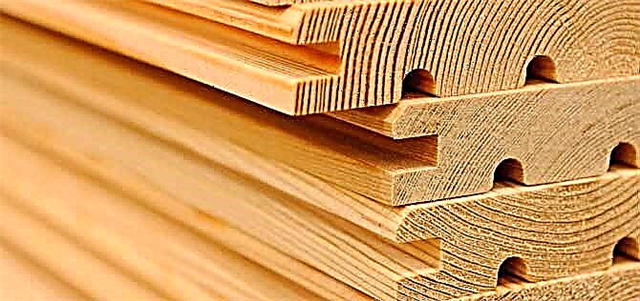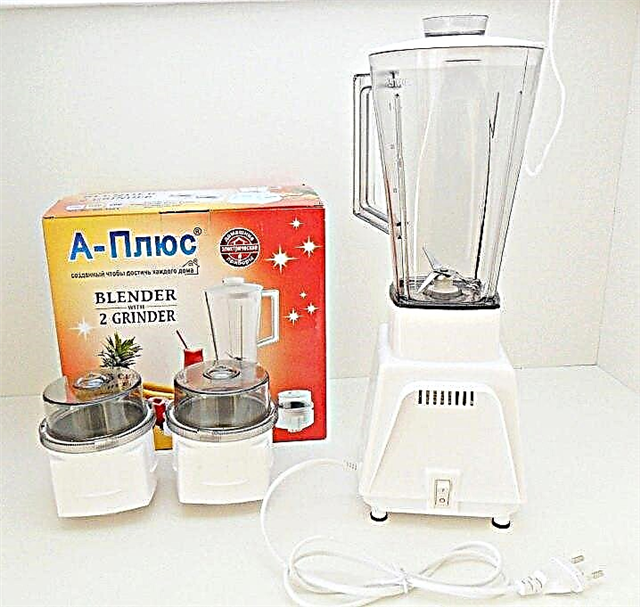Laying the mosaic is no different from ordinary tiles, but it has some nuances. First of all, it is worth noting that you will need to buy special glue for mosaic tiles, it is produced by well-known Knauf and Serezit firms.
In addition, the glass tile mosaic is laid only on white glue, gray will be illuminated under it and spoil the whole appearance. Glue for mosaic tiles is distinguished by its texture. It must be diluted densely and applied to the wall with a thinner layer than for ordinary tiles. If the glue is liquid, then the mosaic will slide down. If there is an excessive amount of glue on the wall, it will protrude through the grid in large balls, and it will need to be constantly removed.
The mosaic tile is most often applied to the wall, after preliminary marking it into several sections, on which several parts will be located. To apply glue, you need to buy a special notched trowel that makes shallow and not deep furrows. To cut the mosaic, you don’t need a tile cutter, but you will need to find special nippers to cut the base.
Laying any tile requires a perfectly flat surface, so the most time-consuming stage will be the leveling of the walls. The wall is cleaned and primed, and then evened with putty on the beacons using the rule. The walls will dry after leveling for about a day, sometimes up to two, depending on the thickness of the putty. After that, it is advisable that they be primed one more time so that the mosaic holds better.
It is worth monitoring the consistency of the glue, if it is dry - the tile will fall off, and if it is very liquid - it will slip. Mosaic is applied to the wall, then excess glue is removed. You can alternate ordinary tiles with mosaics on the same wall, but use different glue for the tiles. If a paper-based mosaic tile is used, then it is applied to the adhesive with the back side, and after the glue dries, the paper is soaked with water and removed.
A day later, after the glue dries, grout should be applied. They use a wide rubber spatula and high-quality grout, which can be not only white, but any other color. The grout is evenly distributed at the seams, and then the tile is wiped with a soap solution.
For laying the mosaic you will need a peculiar approach, on the one hand it is more difficult to glue it than ordinary tiles, but on the other hand the material makes it possible to maneuver. Due to the large number of gaps, it can be squeezed a little and easier to process the protrusions. It is necessary to adhere to the same distance between the gaps, they can only be shifted as a last resort. For ordinary tiles, beacons are used as an alignment of the distance between the tiles. But in the mosaic tile this role is played by the elastic grid on which it is made or paper.
Tile mosaic makes it possible to realize any fantasy, because it is so in demand today. It is used not only for decorating the bathroom or kitchen, but also for swimming pools, baths, night clubs, halls of luxury hotels and other institutions.
Beautiful examples in the interior
There are many interesting ideas for using mosaic tiles in the interior. Moreover, each designer or a simple homeowner can offer something of their own, making the project more individual. Here are a few examples that will help if there are no interesting ideas at all.
Luxurious panel. A chic bathroom decorated not with a simple monochromatic mosaic, but with a full panel. It turns out an antique picture that will appeal to both young creative people and connoisseurs of classics. It is made in three primary colors: cold blue, gray and dark green. This combination of shades looks luxurious and grand. In such a bathroom you can feel like a real queen.
To match the panel on the wall, you can pick up the bathroom. The base is decorated in dark blue and green, and the inside of the bathtub is white, which also combines with the pattern on the wall. The rest of the room is also successfully decorated in a restrained style: the floor is decorated with ornate patterns in black and white, and the walls are decorated with mosaic tiles in the same colors.
Bright bathroom. The second example is a no less luxurious bathroom, decorated in bright colors. As you know, they make the room more spacious. Therefore, the bathroom with a luxurious jacuzzi in the very center of the room seems truly royal.
The desired atmosphere is supported by wall decoration, decorated with exquisite curls. The ceiling and floor are made of light marble, and the steps leading to the entrance to the jacuzzi are decorated with mosaic tiles. It is both beautiful and comfortable. The very basis of the steps is made of less slippery material, which means that you should not worry about safety.
Small lamps and a central lamp illuminate the premises, which seems quite massive, but does not take up too much space. The decor uses delicate flowers in metal mini vases that create a romantic atmosphere in this room.
Delicate patterns. The last design option is the simplest. This is also a bathroom, but already made in a minimalist style. The walls are decorated with light mosaics diluted with beautiful green patterns. To lay out such patterns is much easier than messing around with a huge panel consisting of hundreds of small parts.
The rest of the room looks quite simple. In addition to plumbing furniture, there is only a towel rack and sink, combined with a small chest of drawers. A mirror comes with the sink, which is very good, as they fit each other. Near the mirror are neat lights that provide the right lighting for makeup and morning treatments. The little things that decorate the room are functional and do not spoil the overall impression of the room.
Mosaic tiles - this is a universal solution that is suitable for decoration as an entrance hall or living room, as well as a bathroom and kitchen. You can choose a beautiful cladding for almost any interior, the main thing is to know what shade is needed, and buy a quality product.
How to properly put the puzzle in the video below.
Number 8. Mosaic tiles, or pseudo mosaics
Mosaic with a lot of advantages has only one drawback - the high price. If the cost of the material is the only problem that stops you, then you can cheat and buy mosaic tiles. With the right choice, it will not look any different from a real mosaic, but there are also limitations - you can use a pseudo-mosaic only on flat surfaces.
Mosaic tiles are ordinary ceramic tiles, on which the corresponding pattern is applied. For plausibility, trowel joints are imitated, on the execution of which the final result depends. The entire psdomozoosa can be divided into three types, depending on the simulation of stitches:
- tiles without slots on the surface, where the relief is achieved by stamping on the glaze. After installation, the borders of individual large slabs will be clearly visible, and the imitation of the mosaic is not achieved,
- textured tiles, where only convex elements are covered with glaze, and the boundaries between them are processed at the factory by a substance that simulates a grout. The option is better, but you will have to select the grout exactly in the color of the one used by the tile manufacturer, otherwise the seams will be clearly visible,
- tile with slots is the best option. At the factory, a lot of grooves are made on large tiles, which simulate the seams between the mosaic elements. After mounting the tiles, these seams are rubbed together with the seams between the solid elements, and as a result, a very accurate imitation of the mosaic panel is achieved.
Mosaic is a universal decor that fits perfectly into any style of interior and any room, and a wide range of solutions allows you to choose the option for any budget.
The pros of mosaics
- Versatility, strength and stability to different environments. It can be trimmed with anything from the pool to the living room.
- uniqueness - This material has not changed much since the days of Sumerian palaces and Roman villas, and at the same time it complies with all modern decoration technologies.
- Easy to install - even an amateur can handle modern mosaics.
- variety colors, textures, shapes and sizes.
From the history of the issue
Previously, the mosaic was made of multi-colored stones, smalt or ceramic tiles. It used to be 4 thousand years ago. It was at this time that the Sumerian palaces and temples decorated with mosaics, the earliest buildings known to archaeologists, are attributed. The heyday of mosaic art reached the era of the Byzantine Empire. Refined Byzantine mosaic with delicate masonry of small stones on a gold background is one of the most recognizable styles in the world.
In ancient times, laying mosaics was difficult. First, the artist collected fragments of material of different colors for the intended drawing or ornament. Then the long and painstaking layout process began. Each piece was carefully selected by the master in color and shape, and only after that was fixed on the panel.
It is difficult, but the impression was (and still is) making such that the fashion for mosaic spread to the whole world. And now the styling process is no longer complicated. Remained pure creativity.
How does it work
Even a person with no experience can easily cope with modern mosaics. For ease of installation, mosaic fragments are glued to a special mesh sheet, usually 30 × 30 centimeters in size. Fixing mosaic sheets on the wall is much easier than single fragments.
Often on the same mosaic sheet there are not only different colors, but also different materials that create an interesting combination of textures. Mesh-based sheets are easy to trim to fit the edge of a wall or floor. And if a fragment suddenly becomes damaged, it is easy to replace it without dismantling a large piece of the surface.
Versatility and once again versatility
Mosaic can be used for exterior decoration, and for interior decor - it will endure everything. But this material is especially good in rooms with high humidity. The mosaic has an advantage over the usual tiles - due to the large number of faces and seams, the surface is less slippery. In addition, the abrasion resistance and hygiene of the mosaic tile is not inferior at all.
For mosaics, as in ancient times, they use glass, ceramics and natural stone - they are very easy to care for, they are durable and resistant to environmental influences.
You can’t imagine more original
In addition to glass, stone and ceramics, mosaics are now also made of plastic, artificial stone, metal and even wood! Thanks to this, the mosaic offers such a variety of colors and textures that it is difficult to compete with other finishing materials. Glass mosaic is especially diverse. During manufacture, various fillers are added to it, for example, glitter or metal powder - just imagine what an effect! There is a glass mosaic imitating the texture of different materials: marble, metal, wood and others.
The only thing to remember here: metal or wooden mosaic is not suitable for rooms with high humidity. Glass mosaic is not used to finish the floor in the bathroom or pool. Microcracks may appear in the glass, and it is uncomfortable to walk barefoot on such a floor. But a mosaic made of a material identical to glass - glass melt - is great for swimming pools. Glass melt is an alloy of siliceous sand with the addition of polymers, much stronger than glass.
Renaissance in your kitchen
By the way, inspiration and creativity are inherent in this material at the title level. The word "mosaic" comes from the Latin musivum, which means "dedicated to the muses." The ease of use of a mosaic is as vast as its age. With its help, you can realize absolutely any idea: to recreate the living environment of a Roman villa or the futuristic interior of an interplanetary spacecraft. And if you don’t have time to develop an individual project, you can be inspired by one of the ready-made solutions proposed by the professionals who created the mosaic collection.
Mosaic is perfect for facing any object that has planes - countertops, fountain bowls, steps and risers of a staircase. You can decorate a frame for a mirror, a flower pot and many other decorative elements with small mosaics.
Unleash your imagination
Modern design solutions allow you to combine mosaic with other finishing materials - floor coverings, wallpaper, paint. As a rule, mosaics are used to create bright accents or patterns on a homogeneous surface. An unlimited variety of shapes, colors and textures allows you to seamlessly fit the mosaic into any design decision. So, the mosaic imitating marble is suitable for the interior in a classic style. No less successfully you can use the mosaic in the most modern interiors.
“One of the most popular trends today is the use of porcelain stoneware imitating wood for flooring,” says Alena Podmasco, stylist, Leroy Merlin hypermarket chain. - To create accents of the same color and texture on the walls, a mosaic under a tree is perfect. Another popular trend is ornaments from hexagons, hexagons. Using a mosaic with fragments of a hexagonal shape, you can create unique patterns in which the basic shape of the hexagon that dominates the design of other surfaces will be repeated. ”
Subtleties of styling: 4 important rules
1. The main task in working with mosaics is to leave untouched its natural beauty. For example, to fix the glass mosaic, white glue is used that does not change the shade of the translucent fragments.
2. After laying the mosaic sheets, as in the case of tiles, you need to grout the seams. For this operation, you can use the usual grout for tiles. However, a truly strong aesthetic effect can be achieved using a special grout with glass filling. The faces of small particles of glass reflect light differently, and the seams will literally sparkle.
3. When grouting mosaics made of natural stone, take into account the uneven surface structure of this material. Before grouting, the stone must be treated with a special transparent composition that fills the natural bumps. After grouting, the masking layer is washed off without leaving a trace.
4. For operational repairs, you can use self-adhesive mosaic sheets. On the back surface of the mesh base, glue covered with a protective layer is applied in advance. To create a colorful panel on the wall, it is enough to separate the protective layer and fix the sheet on the wall - almost like a self-adhesive wallpaper.
Features of white mosaic
It is well known that it is the bathrooms that are characterized by a high level of humidity and constant temperature changes. In addition, the bathtub and sink with it are often combined with the toilet in the same bathroom, which is the reason for the high requirements for the cleanliness and sterility of such rooms.For the treatment of surfaces in bathrooms, agents consisting of complex organic compounds are used, therefore, the lining material used to decorate the bathrooms should not only be easily cleaned with their help, but also be resistant to the effects of such chemicals.
To obtain a white mosaic, natural stone is used. This kind of mosaic most often goes to the flooring. Natural stone is known to be durable, durable and resistant to mechanical stress, chemicals and moisture. Mosaic made of natural stone is made of granite, marble, jasper or onyx. The high cost of natural material is offset by its durability and elegance of appearance.
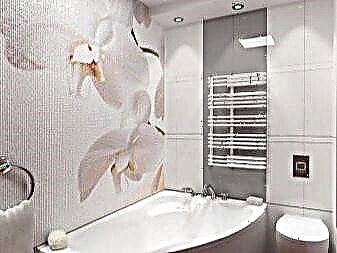
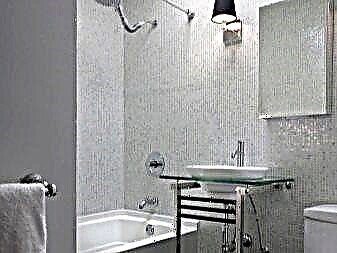
Glass mosaic tiles, along with natural similar products made of stone or ceramics, are popular among those consumers who prefer classic solutions to home decor. The color scheme of the decorative material presented in a wide range, thanks to the brightness of the coatings with all kinds of pastel shades, allows you to realize the most daring design ideas.
Bathroom mosaic resistant to high humidity, and its universal anti-slip surface is reliable protection against temperature extremes and fluctuations in the humidity level in such a room. The daily intense impact on its surface does not affect the appearance of a decorative tiled mosaic and does not harm its base.
The use of glass mosaics saves the owner from the need to perform complex procedures for caring for her; she, like natural stone, is resistant to chemical organics and water.

Ceramic mosaic tiles with a glossy or dull surface are among the most common types of tiles. Among the collections with ordinary rectangular geometry, you can find products of a round or irregular shape that can give additional originality to the interior of the bathroom.
The popularity of ceramics is due to a reasonable balance of price and quality and a wide range of its textures. White tile, most often used for decorating a bathroom, together with the sterility effect visually expands the interior space, which is especially valuable for objects of small area.
Some nuances of finishes
To avoid the effect of hospital sterility, it is necessary to slightly dilute the white color. It is not necessary to do this with a different shade or color of the wall trim. You can use accessories whose color differs from the classic. An example here is the use of a shade approaching white, but with a barely noticeable hint of yellowness or a beige shade, and a combination of pastel colors is also possible.
If the design turns out to be slightly cool, when a combination of white and blue is observed in the decor, then the placement of lighting by several tiers can smooth and kind of melt it. It will be very uniform, and with its help it will be possible to avoid association with the brightness of the hospital room. At the same time, accessories and furniture of almost all colors will organically be combined with a white and beige shade of wall decoration. To emphasize the luxury of the bathroom, it is useful to use a brown, purple and burgundy palette.
If to dilute the design, use not color, but structure, then for this purpose it is necessary to use mosaics of different types of stone, glass and ceramics with matte-glossy surfaces. To give additional contrast to the interior of the room, it is useful to process the seams with black grout.

Mounting technology
Laying the mosaic should begin with the alignment of the walls. Although the mosaic is a very small tile, but unlike ordinary tiles, it not only does not hide small irregularities, but also makes them even more noticeable. Therefore, the prepared surface of the wall, ceiling or floor is leveled and treated with plaster mix or dry plaster.
Given the increased humidity in the bathroom, the surface under the mosaic is treated with an antiseptic compositionto avoid mold and fungus formation under mosaic tiles. For reliable retention of the mosaic, the surfaces are pre-treated with a primer to create the necessary adhesion. Mosaic styling is carried out depending on what role is assigned to it in the interior. If it is considered as a partial decorating design element, then its installation should be carried out flush with the main wall finish. If it is necessary to cover all the walls with it, then laying should be from the bottom corner, moving strips up. If you decide to use a combination with white of several shades and color schemes, then you should number each individual element in advance.

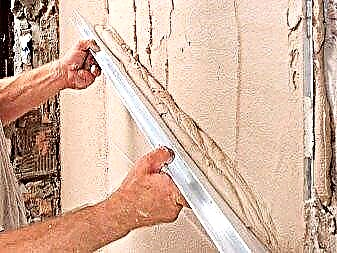
Glue is applied to the surface with a notched trowel, after which the necessary element is applied to the adhesive layer and gently pressed from top to bottom. The adhesive composition is applied evenly so that it accurately reproduces and duplicates all the bends of the surface profile. Do not apply glue to an area that is too large so that it does not set before the mosaic coating is installed.
The adhesive composition for fixing the tile mosaic can be a polymer or be prepared on the basis of cement. It can have a gray color of ordinary cement mortar or white. If the room is decorated in bright colors, it is better to use white glue for this, since unlike ceramic tiles, mosaic fragments are distinguished by a certain transparency, so gray glue will make the mosaic surface darker.
The next element is stacked at the same distance as inside each mosaic matrix. After the glue dries, the seams are overwritten with a special grout.


Advantages and disadvantages
Summing up, it should be noted the long service life, mechanical strength and abrasion resistance of this material. Featuring a wide choice of materials for its manufacture, color schemes and textures, resistance to fading and fading, as well as temperature differences, mosaic tiles are very convenient for hiding defects in walls and floor surfaces.
Although the need for preparatory work before laying such a coating is minimal, this type of coating has some negative properties that should be considered when choosing it. So, although manufacturers supply the market with budget options for mosaics, the cost per square meter of elite collections is very high. Technologically, its laying is approaching the installation of ordinary tiles, but due to the high cost of the products, the owners are forced to turn to the services of professional tilers, as they are afraid to spoil the work by doing it themselves.


Glass, when it comes to the glass version of the mosaic coating, is known to be a brittle material. Therefore, with good wear resistance, in general, glass mosaic tiles are very sensitive to dynamic shock loads and scratches.
In general, tile mosaics are used not only for floors and walls, but also for ceilings, since after hardening the adhesive mixture they become much more resistant material than even tile ceramics. Unlike the latter, the mosaic fragments do not crack and peel off the base much more difficult, and even with such peeling, the mosaic elements can easily be glued back into place.
The bathroom, in the decoration of which a white mosaic was applied, being able to set the tone for an excellent mood, always looks stylish and modern, and the organic combination of colors and textures in it will give the interior the necessary personality.
Types of Modules
Since the process of laying individual particles of a mosaic on a voluminous surface is too painstaking work for a modern person, special modules were created with ready-made assembled mosaic fragments. This greatly simplifies the installation process and avoids color errors when laying out the picture. In appearance, the modules are divided into 2 types.
Types of mosaic tiles
What types of mosaic tiles?
Manufacturers produce elements with different types of surfaces:
- structural or embossed,
- smooth or spongy,
- glossy shiny matte.
This characteristic depends on the feedstock used to produce the coating.
The most common mosaic tiles are made of glass, ceramics, smalt.
Glass tiles are durable, inexpensive, resistant to changes in room temperature, high humidity, chemicals. The material is used for facing the bathroom, sauna, shower, pool, kitchen, for decorating tables, cabinets, as well as bar counters, stoves, fireplaces.
Ceramic mosaics are performed with a glazed surface for rooms with high humidity and for rooms with a dry microclimate with unglazed surfaces.
Smalt tile is opaque, its texture changes color when the light or temperature conditions in the room change. It is a wear-resistant and durable material.
Mosaic tiles are also made of porcelain stoneware, metal, concrete. Expensive types of tiles are made from natural stone (granite, onyx, tuff, jasper), with the addition of gold foil or components that create an imitation of semiprecious stones.
Why is white mosaic?
The opinion that the mosaic is the same tile is only small, not quite true, because it can be made of a wide variety of materials. The size of individual fragments varies from 1x1 to 5x5, they can be square, rectangular and even round. The use of a white mosaic is able to visually increase the space and add light to the interior.

Contrasting mosaic pattern in various shapes
Important! Choosing white as the main color, hygiene measures must be carefully and regularly carried out. Indeed, on white, the dirt will be immediately noticeable.

Light mosaic floor
With the right selection of accessories and furniture, the interior will not be given to a hospital ward, but will become very stylish and modern.
The benefits of using mosaics in the bathroom include:
- convenience of work
- high performance
- aesthetics of the interior.

Dedicated wall in the bathroom with snow-white mosaic
Today mosaic is not only a product of decorative art, but a completely independent and easy-to-lay option for wall decoration, even the ceiling floor.
Fact! The mosaic decoration technique has been used since ancient times, even in ancient Rome small pieces of multi-colored or plain material were turned into a single picture.

An original combination of mosaics of similar tones, assembled in a delicate wall pattern
When was the mosaic invented?
In Russia, the mosaic masonry technique appeared in the X century. Our ancestors borrowed it from the Byzantine masters and used it in the design of religious buildings: cathedrals, temples and churches. The most famous and unique in its beauty works have been preserved in the church of Hagia Sophia in Kiev and the Mikhailo-Zlatoverkhnensky monastery. An example of the earliest decoration of a dwelling by a mosaic is considered to be a panel belonging to the 4th century BC. e., found in Mesopotamia.

Today's mosaic successfully combines the secrets of ancient masters and modern industrial technology. It is durable, beautiful and practical. Her arsenal was replenished with completely new materials that interior designers appreciated.

Smalt
This is perhaps the most expensive and practical material with a bright and saturated color. Opacity, high density and abrasion resistance distinguishes it from ordinary colored glass. Under sunlight, it acquires a pearly tint. It is produced by alloying artificial glass with metal oxides.

Such a glass mosaic is distinguished by a variety of shades (from matte and golden to transparent and silver, including the original ones obtained by pressing the foil between two glasses). It is resistant to prolonged wetting, solar radiation, temperature extremes and detergents. It comes on sale in the form of blocks (modules) ready for pre-laying on paper or a grid, which are transferred in separate fragments to the surface decorated with mosaic. Most often, such a lining is used for decorating fireplaces, bathtubs, pools, baths or saunas.

Ceramic mosaic
It could be confused with tile if it did not differ in such a small size (about 20 x 20 mm) and a more textured texture. For this material, which is used in the same area as ceramic tiles, there are no restrictions on the choice of colors, patterns and intricacy of the finished surfaces. When buying ceramic mosaic tiles, pay attention to its porosity. Unglazed material, unlike non-porous, can cause a lot of trouble during the operation of decorative finishes.

Stone mosaic
In a naturalistic wall decor, stone mosaic has the strength of natural stone, the uniqueness of its texture and color. For the most budgetary works, choose river or sea pebbles, crushed slate, as well as volcanic tuff or travertine. The most exquisite and original panel masterpieces are obtained from semiprecious stones (from jasper, lapis lazuli, onyx, malachite) and rare breeds of blue-blue marble.

Depending on the idea of creating a particular work, the surface of the stone can be polished, artificially aged, etched or coated with gold or silver painting. It is easy to clean, perfectly retains its color, texture, natural strength of the material. Mosaics made of stone are often decorated with hallways, kitchens, flights of stairs, bathrooms, countertops, pools and floors in the halls.

Metal mosaic
Kits of metal mosaic are considered trendy among fans of high-tech style: matte, glossy, steel or golden mosaic surfaces made of metal (stainless steel, brass or aluminum) built on a ceramic or rubber base with a metal frame.

The wide color gamut of the plates is in perfect harmony with glass and bar counters in the kitchen, with mirrors and ceramics on the ceilings. The individual elements of such decorative finishes are ideal for intricate surfaces and rooms with high humidity. Their shape can be square and rectangular, oval and rhomboid. Thanks to modern technology, the surface of metal chips can imitate platinum, gold or silver. If necessary, any of these modules can be easily replaced with a new one.

Mosaic tile options
Facing the material can be done in several ways:
- Create on the surface a plain canvas from small tiles.
- Lay a mixture of colorful tiles.
- Stretch. This is a design method in which a smooth transition is made from dark to light color.
- Facing the main figure with a border from a mosaic tile.
- Combine when laying with ordinary large-sized tiles.
You can also fix ready-made compositions: landscapes, paintings, ornamental panels composed of miniature tiles.
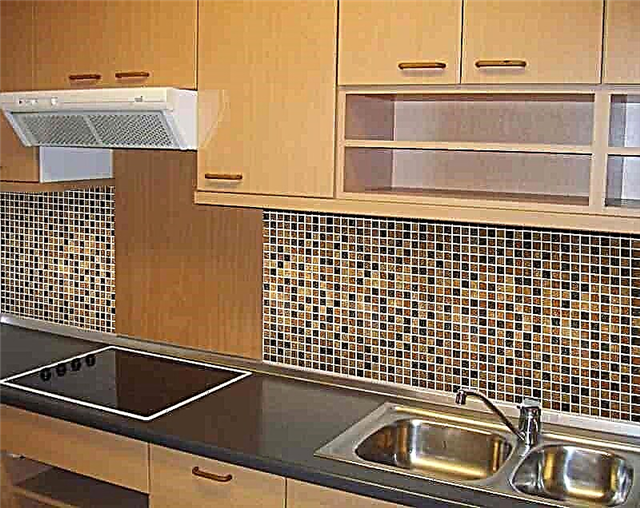
Exterior finish of a private house
As a mosaic for decorating the facade, grout options, for example, black or dark brown, have been especially popular recently. She gives the house an interesting and stylish look.
Mosaic masonry can be done completely on one or several walls, and can only cover the lower part of the house, depending on its design and the desired effect. Particularly interesting is the porch or porch, decorated with small tiles.
White mosaic is actively used for decorating apartments and private houses. She is able to bring cosiness, elegance and luxury into the interior of the room, and therefore is very relevant in the modern market of finishing materials. Designers love it for its versatility, and homeowners for its practicality.
A master class on decorating tables using mosaics, you can see in the next video.
DIY mosaic tiling
Despite the apparent complexity, you can lay the mosaic in the bathroom yourself if you follow a number of rules and recommendations that will allow you to create an unusual interior.
- First of all, you need to properly prepare the surface: align the walls and floor, if necessary, make a screed on the floor and apply a layer of plaster on the walls. From the time of screed or plaster application to the start of further finishing work, a minimum of 7-10 days should pass.
- While the prepared base dries, you can do the selection and purchase of finishing materials, glue for tiles, tools and grouting suitable for color and texture, which will be required in large quantities.
- When the surface is fully prepared, you can start laying mosaic tiles and embody the planned design of the bathroom. The work plan depends on the type of tile and the pattern that you want to lay out. If you plan to make a specific pattern on the wall, first lay it on the floor and only then gradually transfer it to the wall in accordance with the sequence of parts and elements.
To work, you may need several tools:
- metal spatula with teeth,
- rubber spatula
- sponge to remove excess glue,
- knife, if you chose to finish the mosaic on the film.
After applying small parts to the wall or floor, remove excess glue and allow the surface to dry, after which you can start grouting with special compounds selected in color to match the walls and other surfaces.
Mosaic selection criteria
In order for the white mosaic in the bathroom (pictured) to please you with its appearance, you need to carefully approach its choice. To do this, pay attention to the variety. The best solution is the first grade, it will last longer, and will appreciate the quality. On the package in accordance with the international classification, it is indicated in red, the second grade is blue, the third is green. Also in the packaging of the corresponding color will be packaged goods.

Competent and high-quality work in mosaic wall covering with a beautiful transition to a darker shade
An important indicator is wear resistance. On the box with the mosaic there will be a foot icon on a shaded background. The resistance to the aggressive environment will be indicated by the image of the bulb. Mosaic for the floor should have high strength and anti-slip surface.

For the floor in the bathroom, it is preferable to choose a tile made of natural stone. It is durable, non-aging, and anti-slip.
Mosaic in the interior of the bathroom
The main thing here is to maintain harmony between shades and selected materials. The bathroom can be fully tiled, or alternate it in some places with tiles.
Important tip: It is necessary to select several tones so that one seems to go into another, otherwise the lining will look vulgar. Meanwhile, the transition should be smooth, not sharp.
You can interestingly and originally lay out a mosaic in the center of the bathroom, or refine the area around the mirror, decorate the wash basin, or even the bath. In general, there are more than enough options, the main question is only in financial possibilities. As for the material, then it can be any. The only thing worth noting is the selection of mosaics
for laying the floor. If water gets on it, the material will in any case become slippery, which can cause injury. This is especially true for glass mosaics.
Helpful advice: if the bathroom is small, it is recommended to use a mosaic of light colors, as it will visually increase the space of the room.
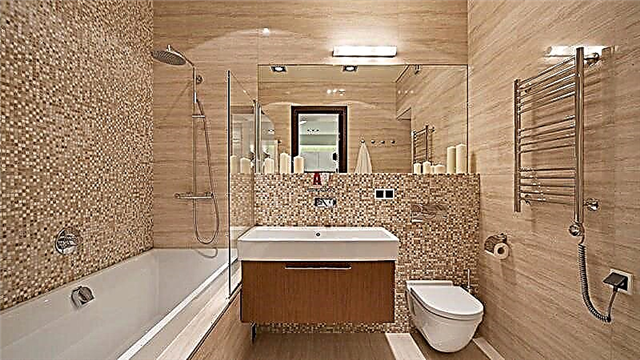
Extra mosaic care
To maintain the original appearance of the design of the bathroom and extend the life of the tiles, it is necessary to ensure proper care. Despite the fact that this material is resistant to aggressive environments, it is advisable to wash it all with a sponge with gentle types of detergents.
- Each time after taking hygiene procedures, wipe the tile elements to prevent the formation of mold and limescale. Some interior decoration companies recommend varnishing the walls. This measure will protect against fungus and mold, but will lead to yellowing of the surface, as the varnish reacts to ultraviolet rays.
- An important role in maintaining the quality of the walls is played by the presence of good ventilation, which will remove excess moisture from the room, thereby protecting the walls and floor from the formation of a destructive fungus.
Mosaic is a unique material that can create an interior in a variety of styles. In addition, with its help you can visually lengthen or expand the bathroom, make the ceiling higher or, conversely, make the bathroom more compact and comfortable.
If you are not ready for long-term work on finishing small details of all walls in the bathroom, then you can limit yourself to small panels, pedestal decoration for the bathroom or sink. The possibilities of the tile are endless, the main thing is to have a desire for innovation and design imagination.
In the absence of the possibility of mounting ventilation, surfaces can be regularly treated with fungicidal compounds, which are widely represented in construction stores.
Thus, to make an original bathroom design is both difficult and easy, if you adhere to the recommendations. The interior will be unique. Good luck See more about the styles and colors of bathrooms.
White mosaic in the bathroom: installation according to the rules
A stylish solution without skillful implementation will not give the desired effect. Therefore, you need to clearly maintain the sequence of laying mosaics in the bathroom.

A noble combination of delicate shades of mosaic with laminate in the decoration of the walls of the bathroom
- In order for the mosaic to hold firmly to the wall, it should be pre-treated with a primer, it creates increased surface adhesion.
- Laying tiles depends on what role the mosaic plays in the interior. If it is a partial decorative element, then you need to lay it flush with the main wall decoration. If it will cover all the walls, then you need to start laying from the corner below and move in strips up.
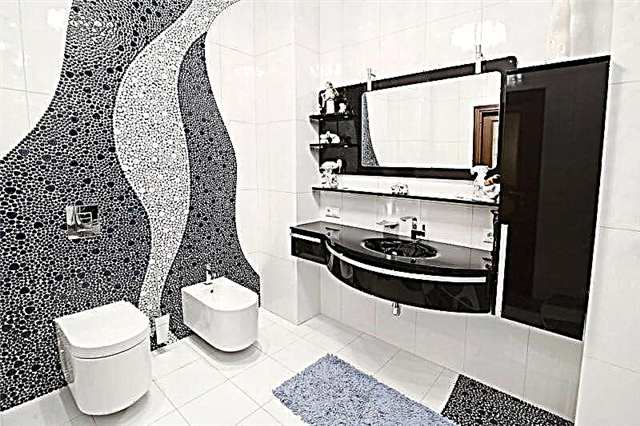
Wall mosaic pattern of different sizes and shapes
Advice! If you use a combination of several shades or colors with white, you must first number each element.

Luxurious mosaic painting in warm colors
Mosaic technique:
- On the surface, apply special glue with a spatula with teeth.
- Attach the necessary element to the glue and gently press it from top to bottom.
- When laying the next element, you must maintain the same distance as inside each mosaic matrix.
- After the glue has dried, wipe the seams with a special grout of white or contrasting color.

You can decorate the wall in the bathroom by combining ceramic and glass mosaics of the same tone, creating a simple pattern
Output
A stylish and modern bathroom, in the decoration of which white mosaic is used, is able to set the tone for the mood for the whole day. A competent combination of colors and textures in mosaic decoration can make the interior truly individual and unusual.

Hexagonal mosaic made of natural stone in a small bathroom
Tips from professionals
- White mosaic expands the space, makes it brighter. She is able to radically change the appearance of the room.
- Adds elegance to the interior, emphasizes sophistication and a sense of style.
- Black and white combination should be chosen for medium and large bathrooms - this will make them harmonious and holistic.
- Small mosaic looks great in any bathroom, but do not forget that caring for it is somewhat more difficult.
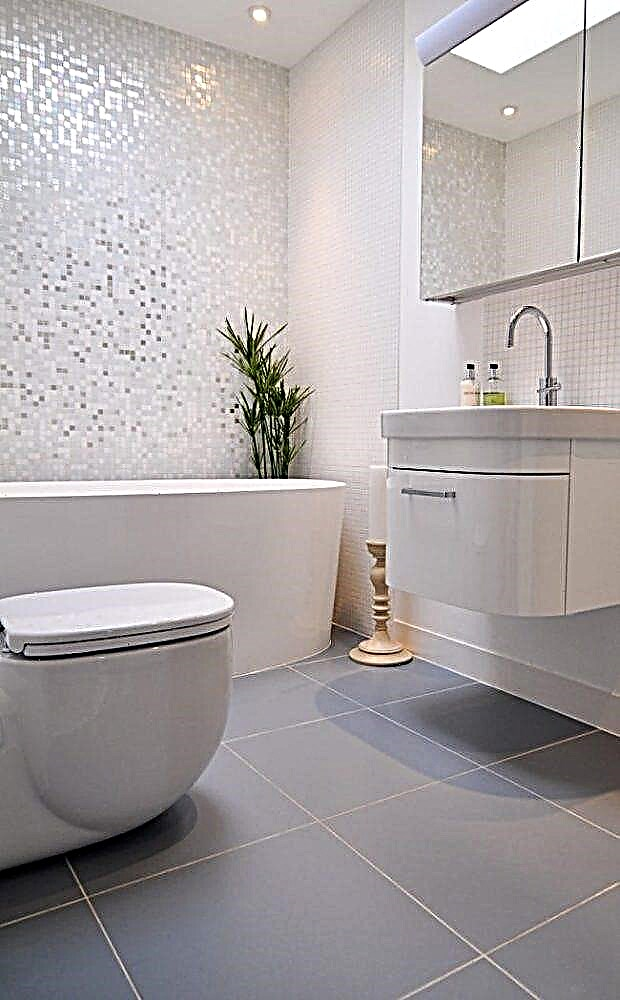
A small joint bathroom will appear wider due to snow-white glossy walls, furniture and mirrors
- Having made a contrasting floor and walls, you can create an unusual design solution in the most everyday and standard bathroom.
- The use of several shades of white mosaic will allow you to create unusual stencil drawings on the walls, ceiling and floor. If the room has a large window, the decoration in white will become a kind of frame for the beauty of nature.
- This color will be the best solution for adherents of minimalism and rigor in decoration.

A contrasting floor and a niche bathroom visually increase the room
Mosaic styling methods
Mosaic is produced in the form of individual fragments of various shapes and sizes. This is an important detail in the decoration. To lay out the mosaic in a quality manner, it is better to first assemble it into the necessary matrices.
Inside, mosaic tiles are attached to each other to a grid or a special film. On the shelves of supermarkets you can find ready-made matrices and panels. In online stores you can order mosaic compositions for interiors according to the photo of the desired design.
Stacked mosaic butt. Fastens with special adhesive bases and pastes for grouting joints. The popularity of mosaics does not go out of fashion, since the beauty of its coating, resistance to external influences, and durability make it indispensable in places where there are bumps, drops, and ends of surfaces.
In the kitchen, it is better to use a mosaic of ceramic matte shades or tile mosaics. It is possible both joint and separate combination of several types of mosaics, creating an original attractive interior.
The mosaic finish is ideal for large, spacious kitchen areas. It can be used as a working material for a wall, worktop countertops, as well as decorating details. For miniature rooms, creating bright accents on the working surface of the wall is suitable. The variety of color palette is far from the limit.
The entire process of laying out the mosaic, despite the difficulty of joining, will not take much time. The only thing that is required of you is patience, perseverance and accuracy in work.
Bathroom
Quite often, typesetting compositions are used when decorating a bathroom. Popular options are glossy mosaic or canvas with a marble print. As a material, it is better to give preference to glass or natural stone. They will most interestingly emphasize the design of the room and will be most practical in terms of wet cleaning.

The unbridled imagination of decorators does not limit the way of decorating. The most popular of them are:
- Decoration of one "leading" wall. Typically, this is the surface behind the sink or directly to the bowl of the bath. There are no options for execution. For example, there may be a classic solid perfectly white canvas made of matte elements or a gradient that is fashionable today - a smooth transition from dark mosaic to white.
- Decoration of several zones. Actual for bathrooms that have a large area. Mosaic can be decorated with opposite corners of the room or other parts of the walls. Typically, the feature is symmetry, due to which the design looks ordered.
- Decoration of a separate part of the bathroom, namely the screen. In private homes, the washing bowl is often placed in concrete mortar, and its surface is decorated with mosaics, which looks very expensive.
- Decor of the ceiling and (or) floor. White typesetting tiles are very often used when laying the floor or decorating the ceiling. This option looks luxurious and interesting, allowing home owners to enjoy the resulting design. Elements for the floor should not be glossy so that the surface does not become slippery when water enters.
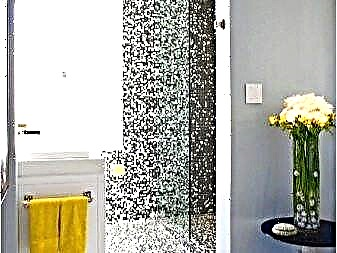
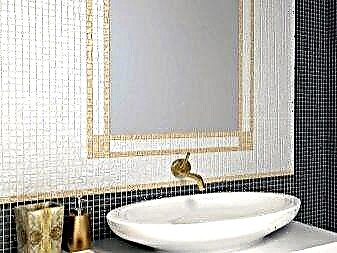


As an additional color for decoration, modern designers advise to prefer burgundy, green, black or blue.
Kitchen and dining room
In this case, there are many more options. You can use both ceramic fine matte tiles and glossy. With the help of mosaics, an array of furniture is most often drawn up - a space outside the kitchen corner, a bar counter or an island in the kitchen.
White texture panels can be purchased before purchasing furniture. for such premises as they will ideally be combined with any of the acquired options. As an additional decor, tiles with a pattern or a different color that diversify light areas are perfect.

In the dining room of a private house, where there is a fireplace, mosaics are often used by decorators to highlight this element of the interior. An array above the hearth is usually made of marble or other durable natural stone. Often also the owners of the cottage for a spectacular room design order massive dining tables, whose surface is decorated with fine tiles.
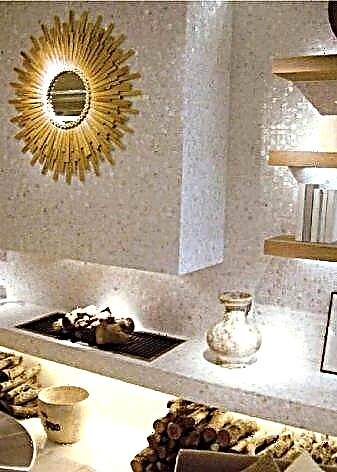

Bedroom and living room
The ways of introducing such decoration into the bedroom interior are extremely diverse. Usually, owners prefer irregularly shaped models. The atypical and even slight negligence helps to give the room a charm and a share of comfort. So, large white tiles of arbitrary shape often fit the upper part of the room, which creates an interesting effect. Small round tiles are also used to decorate individual elements of furniture, for example, the base of a bed or a cloth of a mirror.
Laying the floor from a shallow mosaic of a milky shade will help to make a luxurious living room. Together with a plain carpet, it will create a cozy atmosphere and refresh the interior of the room. Also, designers often lay out massive white windowsills or windows between the windows in order to make the rooms visually lighter and larger.
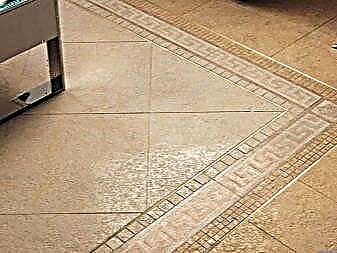
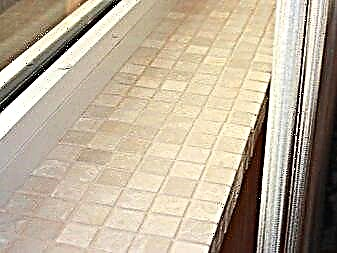
Subtleties and features of the use of mosaics for cladding
Not so long ago, mosaic was considered the prerogative of the rich Ottoman palaces, in which the sultans and their concubines did not go for a long time. The luxury and originality of colors, patterns and ornaments simply could not fail to attract the attention of the general public. At first, mosaic became popular with wealthy people, and over time it migrated to ordinary apartments and houses of average citizens, since with it any interior begins to play with new colors.
Before deciding to make a mosaic of broken tiles with your own hands, you need to be fully prepared for the fact that you will have a difficult, long and painstaking work. If the priority is saving time and speedy completion of repairs in your home, then it is better to refuse such an element of decor, and if attractiveness and beauty, then you need to roll up your sleeves and work hard.
It’s not at all necessary to spend huge sums on the purchase of pieces of marble to create a beautiful picture, because the mosaic made of broken tiles looks no worse, which is clearly visible in the photo, and will cost several times cheaper than natural stone, or even it can be made from unused cladding waste other premises, for example, a bathroom, kitchen, bathroom or pantry. Mosaic is used to improve and finish a wide variety of surfaces in a variety of rooms.
- Facing walls and floor coverings.
- Variety and decoration of building facades.
- Decorating garden paths, patios and other similar places.
- Laying the bottom in pools, ponds and other reservoirs of man-made origin.
- Decor of furniture, crafts, elements of a non-functional plan, that is, all kinds of decorations.
Beautiful, unusual patterns can be made up of anything, and the most affordable material for this can be called broken tiles, since it is easy to get it for free
It is also important that any home craftsman can lay out such attractive and original drawings for mosaics from broken tiles that his imagination can only, and choosing colors and texture is a matter of technology
About the features of laying mosaic tiles
Now it's time to figure out how to glue the mosaic tiles for the bathroom.
First comes the preparation of surfaces, the acquisition of all the necessary materials and tools. The base on which the cladding will be made must be perfectly aligned. If a screed is made, then the installation of ceramics begins only after 10 days.
The installation process begins with the preparation of a sufficient amount of waterproofing adhesive for walls and adhesive for the floor from a cement screed.
First, markup is done where the material will be located. Now you can apply glue for several rows, but not on the entire surface.
We begin the neat laying process. PHOTO: rumosaic.ru
The first row is laid especially carefully, the evenness of the rest of the cladding will depend on it. The material is firmly pressed to the surface. PHOTO: plitka-pol.ru
The material is firmly pressed to the surface. PHOTO: plitka-pol.ru
When pressing on the tile, excess glue should not protrude, otherwise, the spatula is not selected correctly. The remaining glue is removed and grouting is done. At the end of the work, do not forget to polish the lining with felt.
It is better to start using the bath only after two weeks.
It should turn out beautifully. PHOTO: tavannaya.ru
We are waiting for an invitation to evaluate your mosaic works and new ideas!
How to issue?
Today, mosaic is actively used in the design of various residential premises. When decorating a room, modern designers often turn to already proven, popular ways of decorating furniture elements and walls, which bring chic and elegance to the interior. Especially often, tiles are part of the decor of the bathroom (due to its operational qualities). The following design options are available:
- Bathroom screen decoration. This is a fashionable design move that is used to create the design of small bathrooms. As a rule, this is the use of tiles of different shades of the color palette, which are as close as possible to the gamut of the rest of the interior of the room. This option unobtrusively emphasizes the design and makes the appearance of the room more interesting.
- Wall decoration. Often, apartment owners decide to replace an ordinary plain tile with a bright set of small tiles. So it turns out to “revive” the room and give it a more spectacular look. For decor, you can choose one or several walls, as well as a ceiling or floor.
Mosaic on the floor: what happens
In short, the variety of floor mosaics depends entirely on the material from which it is made - how many suitable materials exist, so many types of mosaics. Rather, subspecies that combine into several large groups.
Tiled mosaic for the floor. This is almost the same option as with the wall material of this type - such a mosaic is made of small tiles that are attached to the grid. If we talk about subspecies of this group of finishing materials, then among the frequently used materials, ceramic and glass mosaics can be distinguished. The main advantages of ceramic mosaics on the floor are the relative cheapness and variety of colors, and the strengths of glass mosaics on the floor include strength, depth of perception and not much less variety of color solutions.
Mosaic of artificial stone - made of concrete with the addition of dyes. This is some similarity to modern paving slabs, which, unlike ceramics, has higher technical and operational characteristics.
A mosaic of a mural for a floor can be distinguished as a separate variety - it seems to stand separately outside the types described above, since any type of mosaic can be used to make a mural. The picture on the floor can be made of ceramic or glass, as well as natural or artificial stone. In simple terms, this is a picture, i.e. an insert in the floor, the vocation of which is to decorate.
Mosaic mural on the floor photo
Bathroom mosaic tile
The range of mosaic tiles for the bathroom is wider, and for decoration of the walls most often used tiles on a grid or paper basis. This base helps to position the drawing in the correct position. One tile has many colors and different tones of the same color.
If it is green, then on one base there will be small parts from light green, lettuce, to malachite color. The mosaic tile is valuable in that the designers embodied the most unimaginable transitions of color and shades on it. They are selected not only in tone, but also in contrast.
Tiles for hammam cladding will look especially beautiful, where all walls and objects are covered with mosaic tiles - from walls and floors to benches and tables. The bathroom has a tiled mosaic space under the bath or shower.
Photo of mosaic tiles for the bathroom
We also recommend viewing:
- White tile in the bathroom
- Mirrored ceiling in the bathroom
- Bathroom tile in Leroy Merlin
- Fashionable bathroom tiles
- Drywall ceiling in the bathroom
- Laminate for bathroom
- Plastic ceiling in the bathroom
- Layout tiles in the bathroom
- Wooden floor in the bathroom
- White bathroom floor
- Fixtures in the ceiling in the bathroom
- Laying tiles in the bathroom
- Bathroom Ceiling Finish
- False ceiling in the bathroom
- DIY bathroom ceiling
- The height of the bathroom from the floor
- Bulk floor in the bathroom
- Waterproofing the bathroom floor
- Slatted ceiling in the bathroom
- How to make a bathroom floor
- Warm floor in the bathroom
- Bathroom floor
- Floor tiles in the bathroom
- Bathroom Tile
- Bathroom tile on the wall
- Bathroom lighting
- PVC ceiling in the bathroom
- Stretch ceiling in the bathroom
- Ceiling in the bathroom
- Old tile in the bathroom
- Bathroom floor screed
- Color tiles in the bathroom
- Bathroom Floor Repair
- Ceramic tiles for the bathroom
- Wall mosaic tile
- DIY bathroom floor
- Bathroom Tile Design
- 3D floors in the bathroom
Please repost
Choosing the right glue
Laying mosaic tiles can be carried out using various adhesive mixtures:
- Home-made solution based on sand and water. This is the simplest and cheapest option, which is based on fine sand and high quality cement. The hue of the adhesive mixture depends on the type of cement used. For a glass surface, this option is not particularly suitable, it is also better not to put it on a drywall wall (the base may become sour).
- Standard tile adhesive. This option provides good adhesion, but has a greenish color, which can ruin the appearance of the finish.
- A polymer-based mixture is the best choice for rooms with high humidity. It is based on polymer components that provide quick drying and good fixation. Such glue is suitable for any mosaic.
- Epoxy compound provides reliable bonding. On this basis, the lining can last more than 10 years. The only negative of this option is its cost (this is the most expensive mixture).
- If the material is glued to the countertop, it is better to use liquid nails instead of tile glue.
Best options
If you like low-key tones, you can decorate the walls in the bathroom with sand-colored materials. For example, the upper part of the ceilings can be a one-color cream shade, as well as the lower one, and the middle should be laid out with square tiles with sand, brown and black spots. Against the background of this finish, chocolate cabinets and wooden doors will harmoniously look, as well as simple white plumbing.
For refined and elegant interiors, diamond-shaped glossy mosaic tiles of light shades are perfect. She can lay a wall at the pastel sink (near her or behind). The tandem should be completed with simple wall sconces with elongated yellow woven shades and a discreet rectangular mirror above the sink.
Bright tiles under the mosaic with a blue background and black splashes can be decorated only certain areas in the snow-white bathroom. For example, it can be protruding elements of overlappings, niches, as well as a box of drywall surrounding a white bath. In such a space, the remaining areas should be left plain white.
A similar accent can be made in the bathroom, trimmed with large pale gray tiles. In such a room, a white-gray-brown shallow mosaic should finish one of the protruding walls, for example, behind the toilet.
See how to make a choice between tiles and mosaic in the next video.
Features of laying mosaic tiles
Laying mosaic tiles is not an easy process, but you can also master it yourself if you wish. One of the main stages of installation is surface preparation. It must be cleaned of the old finish, crumbling fragments. If finishing work is carried out in an operated room, it is better to align the walls with plaster or starting putty. To do this, after stripping, apply a primer and allow it to dry. This will give additional adhesion to the building mixture. After that, armed with a spatula, the working solution is sequentially distributed on the surface. It is worth checking the level of the evenness of the plane in order to achieve an ideal base for the finish. Once the treated area has dried, it must again be primed.
Mosaic tiles are fixed to the surface using special glue. The process is time consuming, and the adhesive composition sets quickly, so it is recommended to distribute it in small portions. Mosaic is attached in small fragments. This helps to make trimming and trimming in a timely manner. Each layer is firmly pressed onto the base with glue. To do this is much easier with a rubber roller. Excess adhesive should be removed immediately with a damp cloth. Products on paper are laid out on the paper side so that after the glue has set, the fixing base can be removed.
A day after the end of the installation, grouting is performed. A rubber spatula is suitable for these jobs. Joints are filled with the mixture to the full depth. It is easy to remove grout residues from a dry surface with a damp sponge. Installation work will be performed efficiently, if the temperature regime is observed (from +5 to + 30 degrees). Adhesive should be selected according to the type of mosaic selected, otherwise fragments may detach. Seams of tiles, which constantly get moisture, it is better to close up with epoxy grout. This will protect the surface from the damaging effects of moisture and moisture.
Scope of application
Decorative, working and operational qualities of tile mosaics allow us to solve a variety of aesthetic and technological problems with its help. It is difficult to disagree with the fact that the bathroom, fully lined with mosaics, makes an indelible impression and resembles an exquisite expensive box. Confuses in this case, only one thing - the price of the issue. This design can hurt your pocket.
But since mosaic tiles are perfectly combined with a wide variety of materials, with a limited budget, it is worth considering options for combined finishes that allow you to achieve amazing decorative effects.
So, with the help of combined finishes you can:
- Facing niches and built-in ceilings. In combination with diode illumination or spots and floor lamps, the room will look very impressive.
- Use mosaic tiles as a substitute for friezes or borders that decorate walls, floors or ceilings and perform zoning, indicating the visual boundaries of individual zones.
- Visually change the geometry of the utilitarian space of modest sizes. Alternatively, you can install a large mirror above the washbasin, depicting the mirror surface with a mosaic edging, and decorate the opposite wall with ceramic mosaic tiles. Mirrors and thoughtful lighting will create stunningly beautiful optical illusions that visually add a small bathroom volume, hiding the design flaws.
- Finish work surfaces around the plumbing, creating a mosaic apron such as a kitchen as protection against water splashes.
- To lining the bathtub, for example, to finish the cast iron bathtub with golden tiles, thereby transforming the design of the room.
- Create images, panels, patterns of varying complexity.
- Decorate a podium with an integrated bathtub or a screen under it, plumbing fixtures, furniture, accessories and mirrors. Facing of countertops, facades of hanging cabinets or a chest of drawers for bath accessories, a bench or box masking utilities. Decoration of open shelves does not require much time, effort and money.

